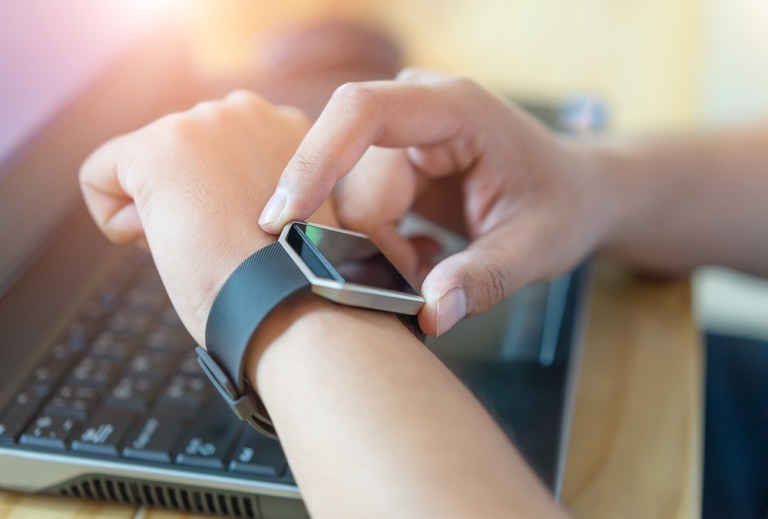
HSBC and Samsung have announced what they are calling a “first-of-its-kind” program to bring wearable technology into HSBC bank branches. The two firms are currently testing a pilot that will put heavily customized Samsung Gear S3 watches onto the wrists of branch employees at HSBC’s three-story Fifth Avenue flagship location in New York City.
The watches and their current deployment, according to HSBC Bank USA Head of Innovation Jeremy Balkin in a joint press briefing on the pilot project, are part of a long collaboration between the two firms on how to best level technology to transform the banking branch experience — particularly in how employees and consumers interact with each other.
Consumers, Balkin noted, still want to use branches. Data consistently indicates that while customers like and frequently use mobile technology, the branch location is still vital to their experience.
The challenge for Samsung, noted by Financial Services Solutions & Innovation Julie Godfrey during the briefing, is to find ways that its technological offering can improve the entire experience in way that is natural and intuitive for the employees, who will literally have that technology strapped to their wrists all day. That meant, she explained, that the technology needed to do three things consistently.
First, it needed to stand on its own from a network point of view, meaning it is connected via LTE rather than running through the bank’s Wi-Fi. Second, it needed to be highly configurable to the bank employees’ specific uses, and be capable of surfacing the right right data at the right time in a way that an employee can easily act on. Third, it needed to effectively tap into Samsung’s B2B security system KNOX. In short, she said, it needed to be an enterprise-grade technology solution packed into a smartwatch.
Beyond all that, Balkin said, the wearable actually has to line up with and serve the needs of workers and customers — a goal echoed by Pablo Sanchez, HSBC senior executive VP and head of retail banking and wealth management, during the kick-off call.
“Our main questions [are] how this works for them — not what someone thought would be the most interesting idea, but what could we build that actually enhances the day of everyone in the banking branch,” Sanchez said.
In practical terms, the firms said, it means making a very large and spread out bank a much smaller and more efficient place. Consumers, from entering the door to accessing the services they are there to use, can expect to wait, on average, about four minutes. The problem with that industry average, Balkin said, is that it lumps together a lot of different kinds of customers walking into many different types of branches. A customer walking into a relatively small suburban bank for a teller transaction can expect to wait less time, for example, than a customer coming to meet with a wealth management expert in a three-story, multi-purpose retail bank like HSBC’s Manhattan flagship branch.
It’s in smoothing out that wait — making it both shorter and more transparent — that HSBC and Samsung agree the technology has really demonstrated strong potential, thus far, in the pilot. A customer waiting on the ground floor for a meeting with someone in the basement might only be waiting for 10 minutes, but 10 minutes of uncertainty while someone at the service desk tries to locate that colleague in the basement can feel like a long time. Those issues happen routinely, Balkin said, because the bank is very large.
The wearable allows a nearly instant and rather hard to miss ping, which means the employee is immediately alerted when the customer arrives for the meeting. Even if the bank official can’t appear immediately, they can offer the service desk real-time feedback on expected arrival time.
By creating a “phygital” experience for the customer and employee, the wait is easier simply because expectations can be managed and uncertainty is minimized. Moreover, the ability of the wearables to track data in real time allows branch managers to get a data picture of where their staff is succeeding and where more training may be necessary.
Employees also enjoy using the smartwatches, Sanchez said, noting they add a “James Bond” feeling to the job.
As of today, only employees at HSBC’s Fifth Avenue location in Manhattan have access to the Samsung customer smartwatch technology — and only through the end of December when the pilot concludes. From there, Balkin said, efforts will turn toward evaluating the data, and figuring out how the program can be tweaked and enhanced so that, ultimately, it can be expanded throughout more branch locations on a more permanent basis.
Neither Samsung nor HSBC had any specific timeline to offer on that further rollout, saying it would very much depend on the data sets they see after the pilot is complete. However, both parties during these early days believe the program will likely roll out, as wearable technology becomes a more mainstream and evolved product — one more suited to the needs of enterprise clients.
“We can now really ask how humans and machines can work together to deliver a superior experience for both the employee and the customer,” Balkin said.